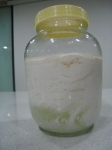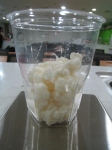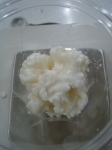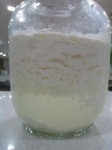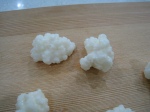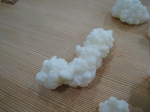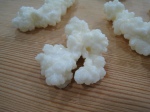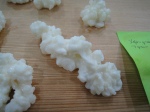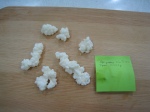Increase in biomass of the kefir grains during their growth 26/6/2012
- Cutlure after 48 hour of fermentation (respectively 86 hours from complete start of the experiment).
- Cutlure after 24 hour of fermentation (respectively 72 hours from complete start of the experiment).
- Determining the weight of the grains on a high percission scale.
- Close up on the cleaned grains before determining their weight on a high percission scale.
- Cutlure after 48 hour of fermentation, close up on the surface area.
- Cutlure after 48 hour of fermentation, close up.
- Cutlure after 48 hour of fermentation.
- Detail of the grains.
- Detail of the grains.
- Detail of the grains.
- Detail of the grains.
- Overview of the grains at the beginning of the experiment 21/6/2012, 19:00.
The goal of this experiment is to find out the increase of the biomass of the kefir grains during their growth in milk.
- Objectives
– monitor the increase of the biomass of the grains
– find out how easy, likely are the grains to separate (handling them with care)
– speed of fermentation, observing the separation of the whey and kefir coagulate
- Ingredients and equipment
whole pasteurized and homogenized milk – Seoul milk brand
kefir culture (grains)
1.5 l glass container
1-3 l glass containers (several)
digital high precision scales Experiment started 21/6/2012 at 19:00
weight boat
2 l bowl
strainer
- Procedure
– warm up 1 l of milk to 30°C and pour it to the bowl
– transfer the grains from old batch (trying to clear them from the excess kefir coagulate) to the bowl washing them thoroughly in a lukewarm milk (30°C) to remove as much of the coagulate as possible
– transfer the grains into the strainer covering them so no insect can infect them and let them drain for 5 minutes moving them around one or two times
– clean in the meanwhile the jar which you used for the fermentation and pure the fresh milk which you used for washing the grains in to it
– transfer the fermented/cultured kefir coagulate and whey to the storage container and move to the cold (fridge 4°C)
– switch up the scales, and “tare” the weight boat on them
– place the grains to the weight boat counting them in the same time, write the number down
– write down the weight
– transfer the grains into the container with the fresh milk
– close the jar and let to ferment at room temperature (in this case 25-30°C)
– open the jar at least once per day to allow for a bit of aeration (advantageous for the yeast)
– note when the firm (kefir coagulate) and liquid (whey) parts start to separate
– after 48 hours take a picture of the culture and note the ratio of separation of the firm and liquid part
– repeat the procedure harvesting the old and starting a new batch of kefir
- Data:
Experiment started 21/6/2012 at 19:00
21/6/2012 – 19:00: amount of grains = 7; weight = 62.2 g
23/6/2012 – 19:00: amount of grains = 8; weight = 65.9 g
25/6/2012 – 19:00: amount of grains = 8; weight = 69.15 g (grains drained just for +-3 min and placed to milk of 20-25°C)
27/6/2012 – 19:00: amount of grains = 9; weight = 72.6 g; the “new grain” is very small
29/6/2012 – 16:30; amount of grains = 10; weight = 84.2 g (the “new grain” is a part of the old one, it is of very small size)
1/7/2012 – 20:00; amount of grains = 10; weight = 87.28 g (the added milk has room temperature)
3/7/2012 – 18:30; amount of grains = 9; weight = 96.27 g (one small grain lost) (the added milk has room temperature)
5/7/2012 – 18:30; amount of grains = 9; weight = 107.57 g (the added milk has room temperature)
The realisation of this experiment would be not possible without support of Susubori Academy, Seoul, Republic of Korea.
- Links to more information:
Guzel-Seydim Z., Kok-Tas T., Ertekin-Filiz B. and Seydim A.C. (2011) Effect of different growth conditions on biomass increase in kefir grains. Journal of Dairy Science 94 (3), 1239-1242.
Guzel-Seydim Z., Kok-Tas T., Greene A.K., Seydim A.C. (2011) Review: functional properties of kefir. Critical reviews in Food Science and Nutrition 51 (3), 261-268.
Simova E., Beshkova D., Angelov A., Hristozova Ts., Frengova G. and Sposov Z. (2002) Lactic acid bacteria and yeasts in kefir grains and kefir made from them. Journal of Industrial Microbiology and Biotechnology 28, 1-6.
Wouters J.T.M., Ayad E. H. E., Hugenholtz J. and Smit G. (2001) Microbes from raw milk for fermented dairy products. International Dairy Journal 12, 91-109.


